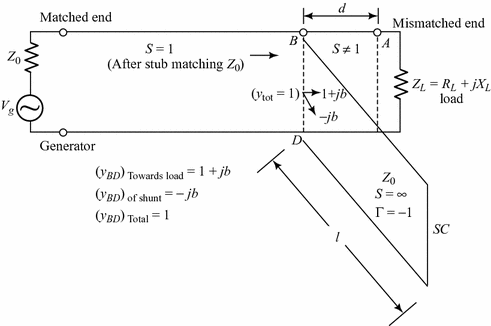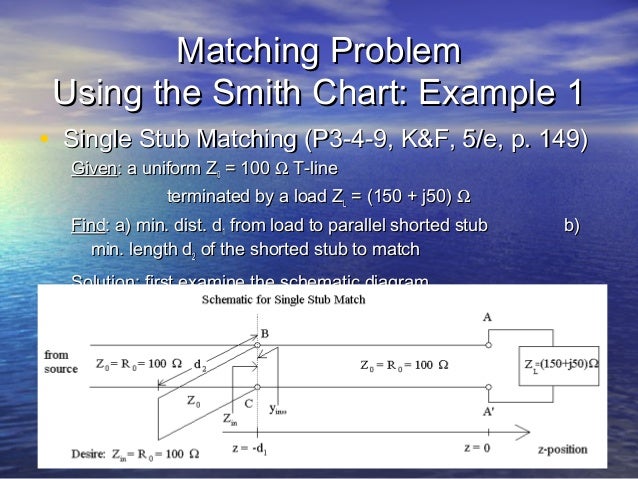
+shunt+tuning+networks+to+match+this+load+ZL+%3D+60-j+80+to+a+50+line%2C+at+a+frequency+of+2+GHz.jpg)
Partial reflection coefficients for a multisection matching transformer ELCT564Ģ3 Binomial Multisection Matching Transformers
#Single stub matching smith chart series#
Assuming that this load consists of a series resistor and capacitor and that the match frequency is 2GHz, plot the reflection coefficient magnitude versus frequency from 1 to 3GHz. The stubs are to be open-circuited stubs and are spaced λ/8 apart. ELCT564ġ9 Double Stub Tunning Design a double-stub shunt tuner to match a load impedance ZL=60-j80 Ω to a 50 Ω line. The second stub then adds a susceptance b2.
#Single stub matching smith chart generator#
Then transforming y1 toward the generator through a length d of line to get point y2, which is on the 1+jb circle. zL=2+j1.6 d1=0.120λ d2=0.463λ z1=1-j1.33 z2=1+j1.33 l1=0.397λ l1=0.103λ ELCT564ġ8 Double Stub Tunning The susceptance of the first stub, b1, moves the load admittance to y1, which lies on the rotated 1+jb circle the amount of rotation is de wavelengths toward the load. Assuming that the load is matched at 2GHz and that load consists of a resistor and inductor in series. ELCT564ġ5 Single Stub Tunning For a load impedance ZL=100+j80Ω, design single series open-circuit stub tunning networks to matching this load to a 50 Ω line. This rotation distance is the stub length l. Beginning at the stub end (leftmost Smith chart point is the impedance of a short-circuit, rightmost Smith chart point is the impedance of an open-circuit), rotate CW (toward generator) until the point at 0 ! jx is reached. The nomalized impedance at this point is 1 + jx. This rotation distance is the length d of the terminated section of t-tline. From the normalized load impedance point, rotate CW (toward generator) on the VSWR circle until it intersects the r = 1 circle. Locate normalized load impedance and draw VSWR circle 2. Assuming that the load is matched at 2GHz and that load consists of a resistor and capacitor in series. ELCT564ġ1 Single Stub Tunning For a load impedance ZL=60-j80Ω, design two single-stub (short circuit) shunt tunning networks to matching this load to a 50 Ω line. Beginning at the stub end (rightmost Smith chart point is the admittance of a short-circuit, leftmost Smith chart point is the admittance of an open-circuit), rotate CW (toward generator) until the point at 0 - jb is reached. The nomalized admittance at this point is 1 + jb.



From the normalized load admittance point, rotate CW (toward generator) on the VSWR circle until it intersects the r = 1 circle. Locate normalized load impedance and draw VSWR circle (normalized load admittance point is 180o from the normalized impedance point). C=1.84 pF and L= nH ELCT564ĩ Single Stub Tunning Shunt Stub G=Y0=1/Z0 Series Stub ELCT564ġ0 Single Shunt Stub Tuner Design Procedureġ. Show the matching process on the Smith chart and plot the reflection coefficient from 0 to 1 GHz. Smith Chart Solutions a) An L section LC network is employed for matching a series RC circuit (R=100 Ω, C=6.366 pF) to a 50 Ω transmission line at 500 MHz. Smith Chart Solutions B=0.29 X=1.22 B=-0.69 X=-1.22 ELCT564Ĩ Matching with Lumped Elements (L Network) Smith Chart Solutions Design an L-section matching network to match a series RF load with an impedance zL=200-j100Ω, to a 100 Ω line, at a frequency of 500 MHz. Network for zL inside the 1+jx circle Network for zL outside the 1+jx circle Positive X implies an inductor and negative X implies a capacitor Positive B implies an capacitor and negative B implies a inductor ELCT564ĥ Matching with Lumped Elements (L Network) 1 Chapter 5: Impedance Matching and TuningĮLCT564 Spring 2012 Chapter 5: Impedance Matching and Tuning ELCT564Ģ Impedance Matching Maximum power is delivered when the load is matched the line and the power loss in the feed line is minimized Impedance matching sensitive receiver components improves the signal to noise ratio of the system Impedance matching in a power distribution network will reduce amplitude and phase errors Complexity Bandwidth Implementation Adjustability ELCT564ģ Matching with Lumped Elements (L Network)


 0 kommentar(er)
0 kommentar(er)
